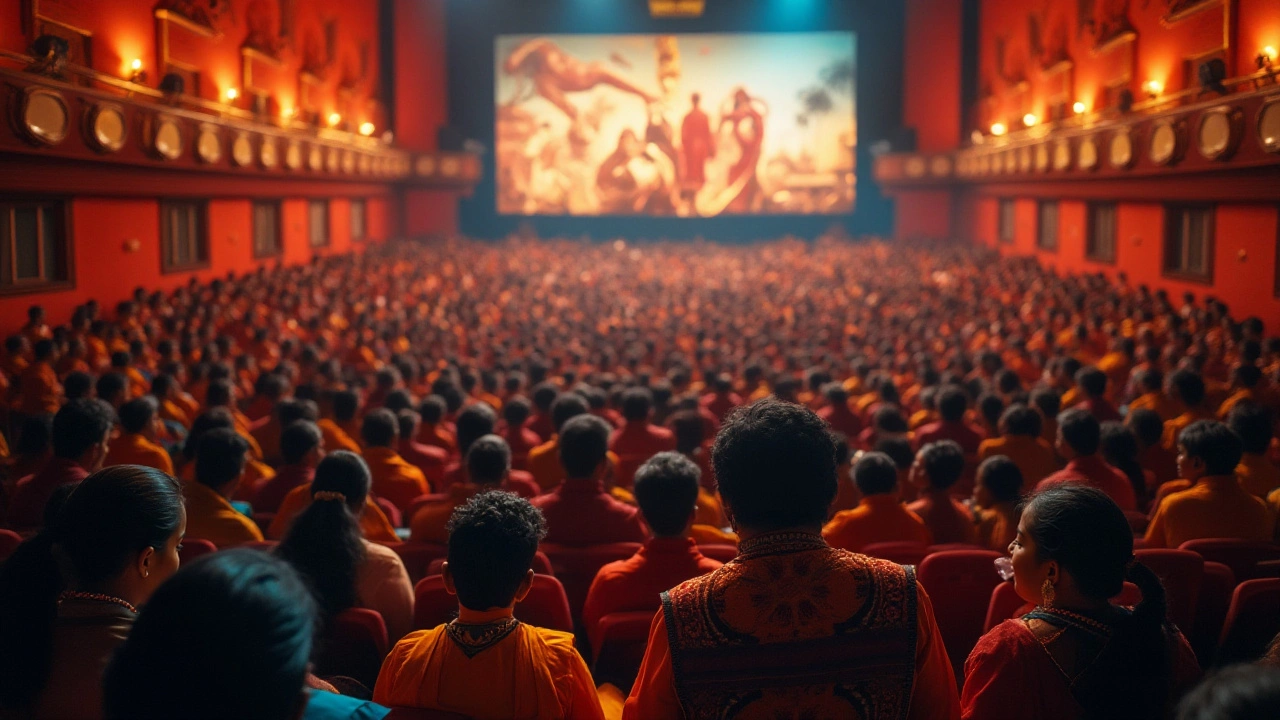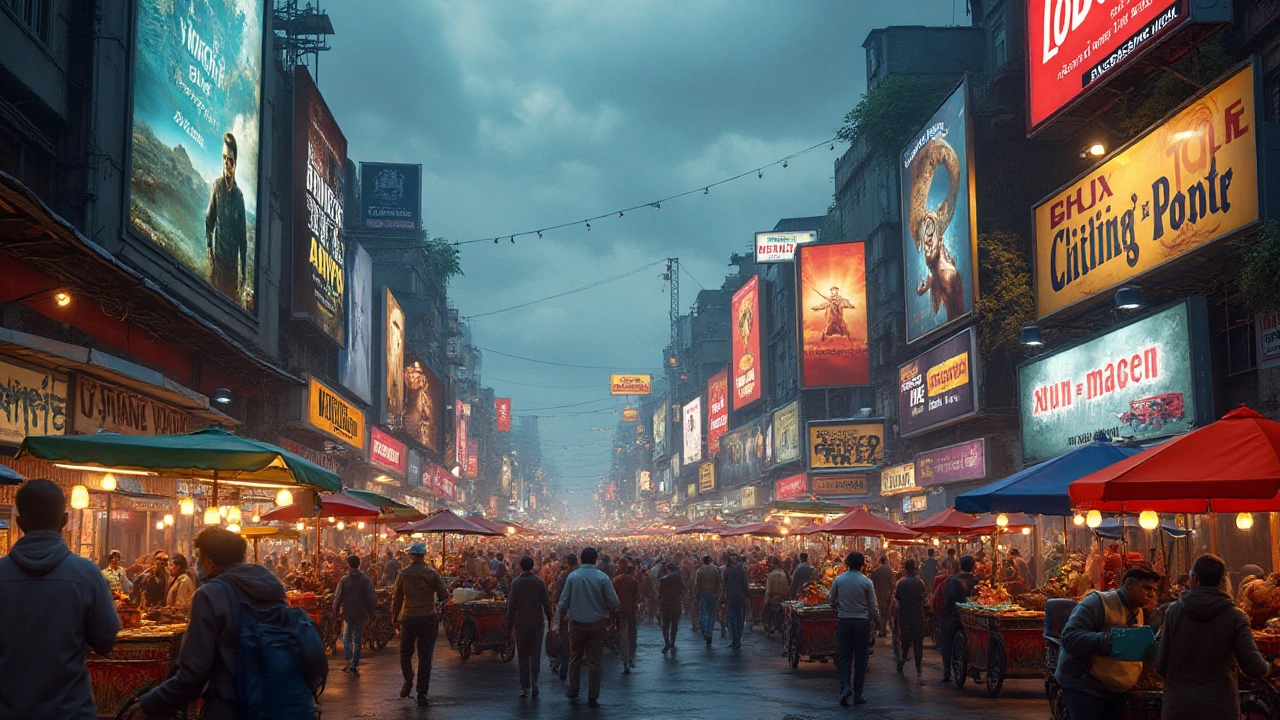Unveiling the Highest-Grossing Box Office Movie of All Time
 Jan, 13 2025
Jan, 13 2025
In the captivating realm of cinema, the question of what makes the best movie is often up for debate. However, when measured by box office success, certain films stand out as titans of the industry. These blockbusters have not only captured audience imaginations but have also set records in financial earnings globally.
Exploring these monumental achievements involves looking beyond mere numbers. It includes the storytelling magic, the star-studded casts that breathe life into characters, and the technological innovations that elevate viewing experiences. Join us as we venture into cinematic history, uncovering the films that have left an indelible mark both on the silver screen and the annals of box office records.
- Introduction to Box Office Success
- Criteria Defining 'Best Movie'
- Historic Blockbuster Hits
- Global Audience Dynamics
- The Role of Technology and Marketing
- Future Trends in Film Industry
Introduction to Box Office Success
The magic of movies isn't just born out of compelling narratives and talented actors; it is also commercially driven by its box office success. A movie's performance in theaters is often the first indicator of its potential financial viability and widespread appeal. Factors contributing to a film's success are myriad and complex, encompassing elements like timing of release, casting choices, marketing strategies, and even external socio-economic conditions. For instance, when a film captures the cultural zeitgeist, it can significantly boost box office numbers. Consider the case of 'Avatar,' whose unparalleled use of 3D technology was perfectly timed with a growing public interest in more immersive theater experiences.
A delve into box office success stories reveals patterns and anomalies worth exploring. Blockbusters often premiere during specific periods such as summer breaks or holidays, when audiences are more likely to visit theaters. The allure of a strong franchise can also magnetize audiences, drawing on established lore and character familiarity seen in series like 'Star Wars' or the Marvel Cinematic Universe aiming to endear their fans. In such cases, even before the first screening, anticipation translates into massive advance ticket sales, highlighting the colossal role of brand loyalty. A strategic marketing campaign can also transform a film's fortune; for example, the use of viral marketing for 'The Blair Witch Project' is frequently cited as revolutionary, turning a modestly budgeted film into a massive box office hit.
"Box office success is far more than just numbers. It's a cultural phenomenon where people come together to appreciate a shared story," reflects film historian Samuel Brandt, emphasizing the communal experience intrinsic to movie watching.
Interestingly, the proliferation of global markets has become an integral factor in measuring box office performance. A film's appeal is no longer confined to domestic success alone; international earnings constitute a large portion of total revenue. As of 2023, films like 'Fast & Furious' have made headlines by earning more than half of their revenue from overseas markets, showcasing the expanding importance of a global audience. Given this, the nuances of local tastes and regional regulatory barriers have become vital considerations for studios aiming to maximize their box office potential. This interplay between globalization and localized appeal accentuates the dynamic landscape in which film producers operate today.
Criteria Defining 'Best Movie'
When it comes to measuring the caliber of what is considered the best movie, the box office stands as a formidable indicator. Yet, it is neither the sole measurement nor always the most telling. To truly understand what defines a top-notch film, multiple variables must be considered. Movies are not just about the dollars they rack up but also about the profound resonance and lasting impact they have on audiences worldwide. First and foremost, a compelling narrative is often at the heart of any standout film. Whether it’s the imaginative intrigue of a fantasy epic or the gripping tensions of a historical drama, storytelling is its backbone, captivating viewers and leaving them pondering the film long after the credits roll.
Another critical component is the performances delivered by its actors. Stellar acting can elevate a script from ordinary to unforgettable, with actors breathing life into characters and inviting audiences to share complex emotional journeys. Consider films like "The Godfather" which showcased performances that became cultural touchstones. Meanwhile, the seamless infusion of technology in filmmaking has created visual and sensory experiences previously unimaginable. From the jaw-dropping animations of "Avatar" to the sublime CGI of contemporary superhero sagas, cutting-edge technology has transformed what we perceive as possible on screen.
Marketing also plays an undeniable role in determining a film's success at the box office. A strategic marketing campaign can build anticipation and rally audiences, creating a groundswell of excitement before a film even premieres. This anticipation can drive opening weekend numbers to record levels, often assuring ongoing interest. For instance, the build-up to any installment of the famed "Star Wars" saga shows that a strong branding strategy intertwined with nostalgia can greatly sway box office outcomes.
The cultural relevance and timeliness of a movie’s themes cannot be ignored either. Films often capture the zeitgeist of their era, reflecting societal concerns, aspirations, and desires at a given moment in time. "Black Panther," with its portrayal of African culture and themes of identity and empowerment, struck a chord globally, demonstrating how films that engage with contemporary issues can galvanize viewer interest. As film historian Mark Taffet once remarked,
"Movies that resonate with societal pulses often do more than entertain; they engage, provoke, and sometimes lead to change."
Lastly, the conscientious, artistic direction and meticulous attention to detail in the craftsmanship of a film can distinguish it from mediocre counterparts. Exceptional cinematography, innovative set design, and carefully curated soundtracks provide audiences with an immersive experience, welding them to the fabric of the story. These production elements work in harmony to create moments that are not merely watched but felt deeply, transforming ordinary scenes into unforgettable cinematic moments.
Collectively, these criteria help form the intricate tapestry that determines the undeniable quality and success of a movie, often translating to box office triumph. It’s a rare blend of artistry and commercial savvy that only some films ever achieve, cementing their status as not just popular, but the top echelon of cinematic genius.

Historic Blockbuster Hits
The journey of cinema is adorned with films that have shattered box office records and transcended cultural boundaries. These blockbuster hits not only captivated audiences worldwide but also became cultural phenomena, etching their names into the fabric of entertainment history. One such monumental film is James Cameron's "Avatar," which enchanted viewers in 2009 with its groundbreaking 3D technology and lush, immersive world of Pandora. At the time of its release, "Avatar" held the title for the highest-grossing film, pulling in audiences eager to experience a new era of visual storytelling.
Another blockbuster that redefined box office norms is "Titanic," also directed by James Cameron. Released in 1997, "Titanic" wove a historically-inspired love story against the real-life backdrop of the famed shipwreck, captivating millions. The film's artistry and emotionally charged narrative helped it dominate the box office for months. What's remarkable about these films is not just their financial success but also the way they resonated emotionally with audiences worldwide, creating a shared cultural experience.
Marvel Studios' "Avengers: Endgame," directed by Anthony and Joe Russo, is another formidable contender. This film brought over a decade of superhero narratives to a climactic end, earning it a prominent place in cinema history. It was a culmination of intricate storytelling and character development, which helped it secure its spot as one of the highest-grossing films globally. The collective efforts of an ensemble cast, complex arcs, and fan anticipation contributed significantly to its box office triumph.
These films illustrate the potent combination of innovative technology, compelling narratives, and strategic marketing that underpin box office success. As noted by film critic Roger Ebert,
"Every great movie provides a gateway into a world more vivid, more animated than our own."Such films transcend mere entertainment, becoming landmarks in global culture.
Indeed, the evolution of cinema signifies a harmonious blend of art and commerce, whereby box office hits reflect both technological strides and the emotional landscapes of audiences. The historic achievements of these films showcase the power of cinema to unite, inspire, and captivate, generating conversations that span generations. Best movies become timeless through such contributions, remembered not just for their figures but for their profound impact on society and the film industry at large.
Global Audience Dynamics
The world of cinema is an expansive and diverse domain, encompassed by myriad factors affecting how best movies gain their stellar status. One of the critical elements that determines box office success is understanding the global audience dynamics. This involves not only knowing what appeals to viewers on a massive scale but also recognizing cultural nuances and preferences that differ across regions.
For instance, international releases can see varied genres performing well depending on the region. While superhero films, with their universal themes of heroism and vibrant special effects, dominate markets in both the West and the East, romantic comedies often find more traction in Europe and specific Latin American countries where storytelling takes a front seat. Meanwhile, action movies traditionally do exceedingly well in Asia, given their focus on dynamic sequences and often minimal reliance on dialogue, which transcends language barriers.
Another pivotal factor is localization. Successful blockbusters frequently employ dub and subtitle strategies to reach non-English speaking audiences, ensuring the story resonates deeply despite cultural and linguistic differences. Marketing isn't just about releasing trailers; it's about tailoring campaigns to reflect local tastes and sensibilities. "For cinema to thrive in the hearts and minds of diverse audiences, it must reflect a mosaic of stories and backgrounds," notes film critic Armand Folkes.
The diasporic nature of modern societies also means movies can often cater to varied taste profiles within a single region. Thus, it's no longer just about where the film is released, but how it's positioned within the cultural tapestry of a location. Digital streaming platforms have also played a transformative role, as they allow instant access to blockbuster films from any internet-enabled device worldwide, further diversifying viewing habits and expectations.
Moreover, the power of social media in gauging audience preference cannot be overstated. Platforms like Twitter and Instagram provide real-time feedback loops that studios use to tweak promotions and sometimes even plot lines or movie endings. Companies have started paying close attention to hashtags and social media trends to align with what the global audience feels good about seeing, ultimately impacting box office statistics.
Finally, technological advancements like 3D and IMAX have redefined what it means to watch a movie, and these innovations have varying degrees of acceptance across different global markets. Some regions embrace advanced formats eagerly while others remain more traditional—affecting box office returns. Thus, the box office isn't as simple as producing gold-standard content; it's about understanding the kaleidoscope of cultures, preferences, and technological affinities around the globe.

The Role of Technology and Marketing
In the world of blockbusters, technology and marketing play pivotal roles in crafting experiences that draw audiences to theaters worldwide. Modern filmmaking leverages cutting-edge technology to create immersive worlds that captivate viewers' imaginations. From the lifelike visual effects in 'Avatar' to the bombastic action sequences seen in 'Avengers: Endgame,' technology pushes the boundaries of what is possible on the big screen. Not only have advancements in CGI and motion capture transformed storytelling, but innovations like the high-frame-rate cinema and IMAX presentations have enriched the viewing experience, offering a grandeur that television can't replicate.
Marketing magic is equally crucial in the journey of a film to become the best movie in terms of box office earnings. Successful campaigns often begin months, if not years, before the movie's actual release. They weave a comprehensive strategy that blends social media engagement, retargeting advertisements, and trailers designed to go viral. An astounding example is the marketing swarm surrounding 'Star Wars: The Force Awakens,' which optimized nostalgia while introducing new characters, resulting in an unrivaled publicity triumph.
"Nowadays, a film's success at the box office hinges significantly on how well it captures public interest before it hits theaters," observes David A. Gross, editor of the movie consulting newsletter FranchiseRe.
The utilization of data analytics in shaping these campaigns cannot be overstated. Studios increasingly rely on big data to better understand audience preferences and predict market trends. Similar to how a tech startup might refine its product based on user feedback, film executives adjust their marketing strategies to target specific demographics. Consider the international markets where localizing content or even tailoring release dates around cultural events can influence the box office significantly. A study by Statista revealed that approximately two-thirds of the global box office revenue comes from international sales, emphasizing the importance of embracing a worldwide marketing perspective.
Finally, partnerships with brands for co-promotions play a crucial part in extending the marketing reach. Familiar examples include 'The LEGO Movie' turning their product into cinematic action figures, creating a symbiotic relationship between toy shelves and ticket sales. Engaging collaborations like these transcend traditional advertising by making the film an integral part of consumers’ daily routines. Successful campaigns turn anticipation into a cultural phenomenon, and when executed well, they transform the film from a simple night out at the movies into a shared event of global proportions. This orchestration, a blend of technology with marketing savvy, is often what crowns a movie as a box office titan.
Future Trends in Film Industry
The film industry is in a constant state of evolution, and anticipating future trends can be as exciting as the latest blockbuster release. As technology continues to advance, filmmakers harness these innovations to shape the next generation of cinematic experiences. Virtual reality and augmented reality are no longer just buzzwords but are gradually making their way into mainstream filmmaking. Imagine a world where blockbuster movies are interactive, where audiences can influence plotlines from the comfort of their homes. This shift promises to redefine the concept of watching a film entirely, merging gaming with traditional storytelling.
Streaming platforms have already revolutionized how audiences consume content, and this trend is expected to burgeon further. With giants like Netflix, Disney+, and Amazon Prime leading the way, these services are becoming more than mere delivery channels. They have become content creators in their own right, producing high-budget films that directly compete with traditional cinema. This shift has democratized film-watching, making it accessible to a global audience like never before. In a post-pandemic world, the convenience of watching films at home with theater-quality content is here to stay.
"The future of the film industry is not about adopting technology for the sake of it; it's about creating deeply immersive and compelling storytelling experiences," said Christopher Nolan, a respected director known for embracing innovative techniques.
Enhanced content personalization is also a burgeoning trend. Streaming services leverage algorithms to curate and recommend films tailored to individual preferences. While providing convenience, this also sparks a new challenge for filmmakers - the need to understand audience data more intimately to create content that resonates with diverse demographics. As personalization becomes more sophisticated, crafting universally appealing films might become a nuanced art.
The role of technology in production is equally significant. Advances in CGI create scenes once thought impossible, blending reality seamlessly with digital magic. Look at the success of films like 'Avatar' and 'Avengers: Endgame', which are built on groundbreaking visual effects. As CGI technology becomes more accessible, we can expect even independent filmmakers to wield it in ambitious ways, potentially leveling the playing field in creative storytelling.
The Rise of Diverse Voices
Another important trend is the rise of diverse voices and stories from different cultures. As global audiences become more interconnected, there's a growing demand for films that reflect a variety of perspectives and experiences. Films from South Korea and India are gaining acclaim beyond their borders, thanks to their unique storytelling styles. This inclusivity is likely to continue shaping the industry, bringing fresh narratives that reflect a broader spectrum of human experiences. With cultural barriers diminishing, the potential for cross-cultural collaborations holds exciting prospects.
In anticipation of these trends, the landscape of filmmaking is poised for unprecedented transformation, one where the boundaries of imagination might only be constrained by our technological capabilities. This dynamic evolution will undoubtedly influence what the next highest-grossing film could be, embracing yet untapped forms of storytelling that could redefine what we consider cinematic excellence.